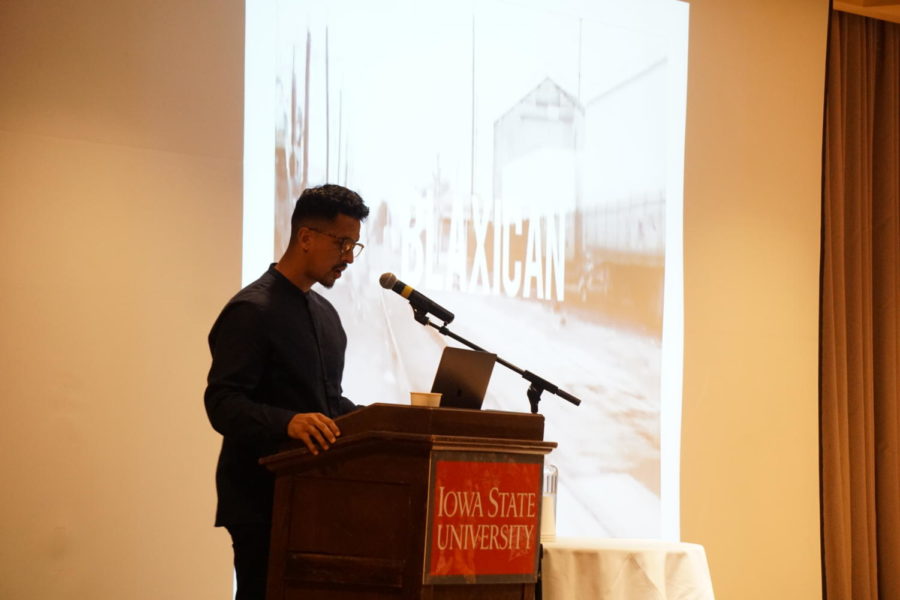Q&A with NY Times journalist Walter Thompson-Hernandez
Journalist Walter Thompson-Hernandez came to Iowa State on Feb. 22 to speak to students about what it’s like being multicultural and speaks about how to define ones identity.
February 26, 2018
Diversity reporter Naye Valenzuela sat down with Walter Thompson-Hernandez on Feb. 22 when he was at Iowa State to give a lecture.
Thompson-Hernandez is a multimedia journalist with the New York Times and grew up in Los Angeles. He has traveled to countries including Madagascar, Cuba, Mexico, Morocco, Belgium and Peru to document multiracial identities and tell stories few in the United States have heard.
His work has been published by VICE, The Guardian, BBC, CNN and other publications.
Q: Have you ever been to Iowa?
A: No, this is my first time.
Q: How are you enjoying it so far?
A: It was great, there’s a lot of kind people. It was really cool this morning; it was snowing. I was like, “Wow, it is actually snowing.”
Q: What inspired you to go into journalism?
A: I think I’ve always been a little curious about the world. I started to understand that the best way for me to tell stories about people and people around the world is by using different media. Using photos, video and writing, I think, allows me to capture three-dimensional portraits of people. I feel like photos can only tell only a part of the story, or words can tell another part, and videos, but when we incorporate all three of those things, I think it allows us to create these real portraits of people and communities.
Q: Were there any setbacks or obstacles you had to face during your work, or even before you went into journalism?
A: It’s interesting that you asked that. To this day I never had taken a journalism class in my life. I’ve never been trained as a videographer or a photographer. It kind of all just came to me and I went on my own by asking questions and traveling. I used different cities in the world as a classroom. Some of the setbacks initially, and sometimes even today, is still learning the technical aspects of things.
Q: Did you ever think you’d be where you’re at now, giving lectures in Iowa?
A: I know I always wanted to do this. I never thought I’d be here, sitting in Ames, Iowa. My lectures, and writing for The New York Times, I never thought I would do it. I knew I could, I just never imagined myself actually doing it. For example, when I had orientation for the New York Times about a month ago, the minute I walked in the building, it felt very natural, like I belonged. It’s like on one hand, I never saw myself doing it but on the other hand, I did [do it].
Q: What inspired you to create your projects?
A: It all started with Blaxicans of L.A. It was the springboard to my career, to journalism. What inspired me was me thinking of my own experience in Los Angeles as a child of a black father and Mexican mother and kind of asking myself, “What does it mean to be a black Mexican in Los Angeles?” and kind of branching it from there and asking the same question to other people that identified in the same way. From that, it was just curiosity about the world and thinking what it means to belong and not belong to a certain identity or culture. It’s been the underlying question to all my stories.
Q: With your work, do you have a specific audience you’re trying to reach?
A: I want everyone, I want every [set of] eyes to see the work that I do. I say that because most of the individuals of the community who I cover and spend time with; I think their story is extremely important and often times there are people in communities whose stories are yet to be told or people in communities whose stories have been silenced. It’s always my goal to work with those people and have as many eyes to see their photos, their words or to experience the world through their lens.
Q: What is your opinion on minority representation in the media?
A: It’s super important. I think there needs to be [a set of] diverse and young voices in the media. I think the general media needs to do a better job of allowing people from different backgrounds and communities of gender, race and sexuality to really tell stories about the world. Most media companies are starting to understand that it’s better to have somebody that can report from a unique perspective, someone who can share a certain racial or ethnic affinity relation. They probably will tell that group’s story better.
Q: Is Blaxican different from Afro-Latinx?
A: Blaxicans fall under that term [Afro-Latinx]. In the same way that Black people from Cuba can identify as Latino/a, Latinx or Afro-Latinx.
















